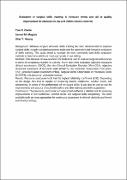| dc.contributor.author | Okello, Tom Richard | |
| dc.contributor.author | Mugada, Samuel M | |
| dc.contributor.author | Ghee, Hwang | |
| dc.date.accessioned | 2021-05-12T09:49:52Z | |
| dc.date.available | 2021-05-12T09:49:52Z | |
| dc.date.issued | 2020 | |
| dc.identifier.citation | Okello, T. R., Magada, S. M., Hwang, G. T., Sutter, F. M., & Lett, R. (2020). Evaluation of surgical skills training: A literature review and call to quality improvement for educators in low-and middle-income countries. East and Central African Journal of Surgery, 25(2). | en_US |
| dc.identifier.uri | https://journal.cosecsa.org/index.php/ECAJS/article/view/20190019/1575 | |
| dc.identifier.uri | https://hdl.handle.net/123456789/247 | |
| dc.description.abstract | Background: Whereas surgical simulator skills training has been demonstrated to improve surgical skills, no gold-standard assessment tools exist for summative and formative evaluation of skills training. This study aimed to evaluate the most commonly used skills evaluation methods to determine which are most appropriate in our setting.
Methods: This literature review examined the tools most used to evaluate surgical skills courses in terms of competency transfer to trainees. Many tools were evaluated: objective structured clinical examination (OSCE), the mini-Clinical Evaluation Exercise (Mini-CEX), objective structured assessment of technical skills (OSATS), the mini-Peer Assessment Tool (mini-PAT), procedure-based assessment (PBA), Surgical Direct Observation of Procedural Skills [S-DOPS], and precourse–postcourse surveys.
Results: Precourse–postcourse tools had the highest reliability coefficient (0.92). Depending on the design, this tool is capable of measuring learner confidence, comfort levels, and competency, in terms of the performance of the taught skills; it can also be used to test for improvements and practice of such skills before and after training and skills acquisition.
Conclusions: The precourse–postcourse self-assessment method is a reliable tool for assessing improvements in self-confidence, comfort levels, and surgical skills competency. The other available tools are most appropriate for continuous assessment in clinical clerkship and formal examination settings. | en_US |
| dc.language.iso | en | en_US |
| dc.publisher | East and Central African Journal of Surgery | en_US |
| dc.subject | surgical skills training | en_US |
| dc.subject | clinical competence | en_US |
| dc.subject | self-assessment | en_US |
| dc.subject | simulation training | en_US |
| dc.title | Evaluation of surgical skills training: A literature review and call to quality improvement for educators in low-and middle-income countries | en_US |
| dc.type | Article | en_US |

